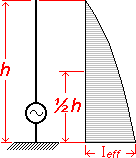Checked out and looked at several articles relating antennas in this Great Site
www.antennex.com
 TRANSMISSION LINE AND ANTENNATRANSMISSION LINE FORMULAS
The characteristic impedance of a transmission line is defined as the input impedance of a line of the same configuration and dimensions but of infinite length. When a line of finite length is terminated with an impedance equal to its own characteristic impedance, the line is said to be matched.

where,
D is the inside diameter of the outer conductor, d is the outside diameter of the inner conductor expressed in the same units as D, kisthedielectricconstantof theinsulating material* (k equals 1 for dry air).
 where,
f is the frequency in megahertz, D is the inside diameter of lhe outer conductor in inches, d is the outside diameter of the inner conductor in inches. Parallel-Conductor LineThe characteristic impedance of parallel-conductor line (twin-lead) as shown in Fig. 2 is determined by the formula:

where,
D is the center-to-center distance between conductors, d is the diameter of the conductors in the same units as D, k is the dielectric constant of the insulating material between conductors* (k equals 1 for dry air).
ANTENNARF Current and Voltage distribution If a RF source is applied to a random length a - b wire then, the current distribution at the open end b will be always low and the voltage will be always high. As seen in the above graph the RF Current and Voltage distribution is divided in the wire appropriate with the physical ½ wavelength intervals Radiating resistor | ||
Vertical antenna
Rs = radiating resistor |
Short antenna compared to wavelength
Rs = radiating resistor | 
|
|
ANTENNA IMPEDANCE

Antenna equivalent circuit Z = Rs + Rls + Sx |
where
Rs = Radiating Resistance Rls = Resistive losses(dielectric, absorbsion, ground, etc) Sx = Xc + XL | |
|
| ||